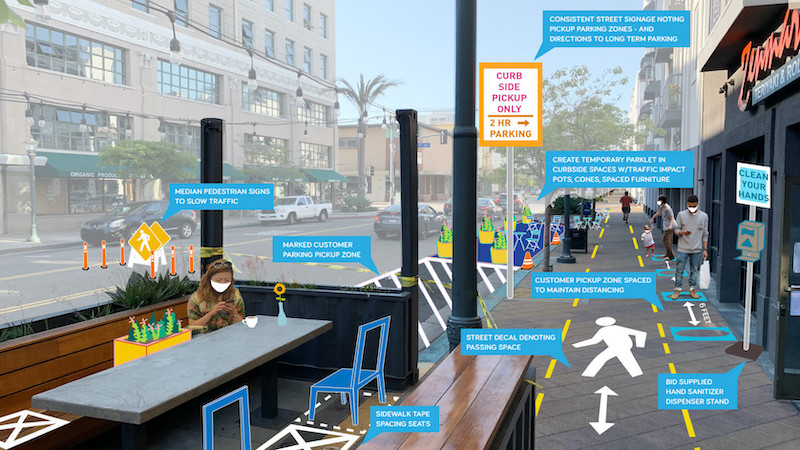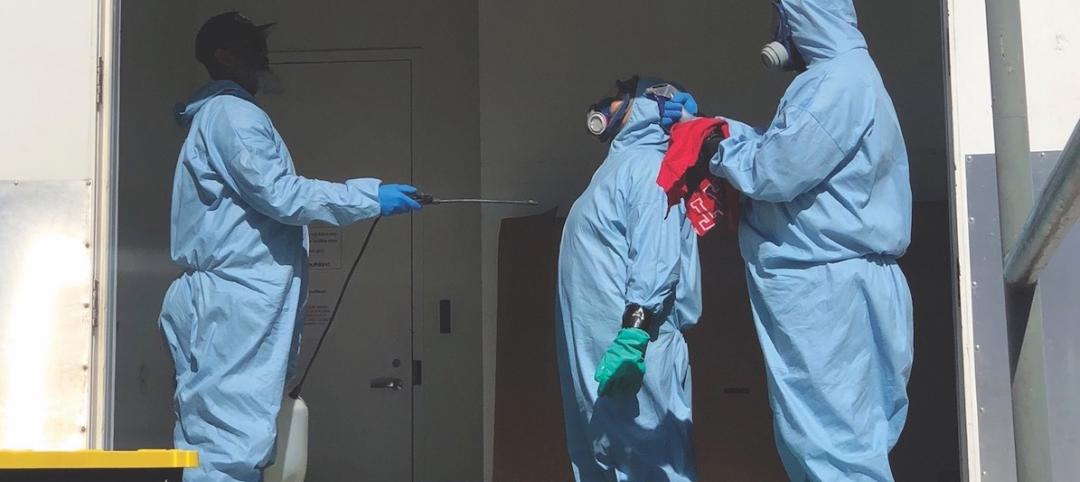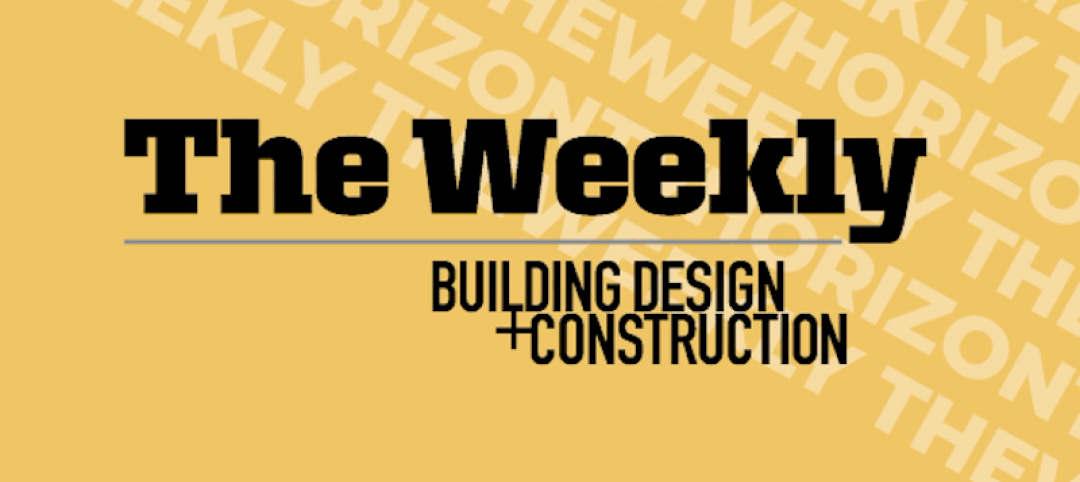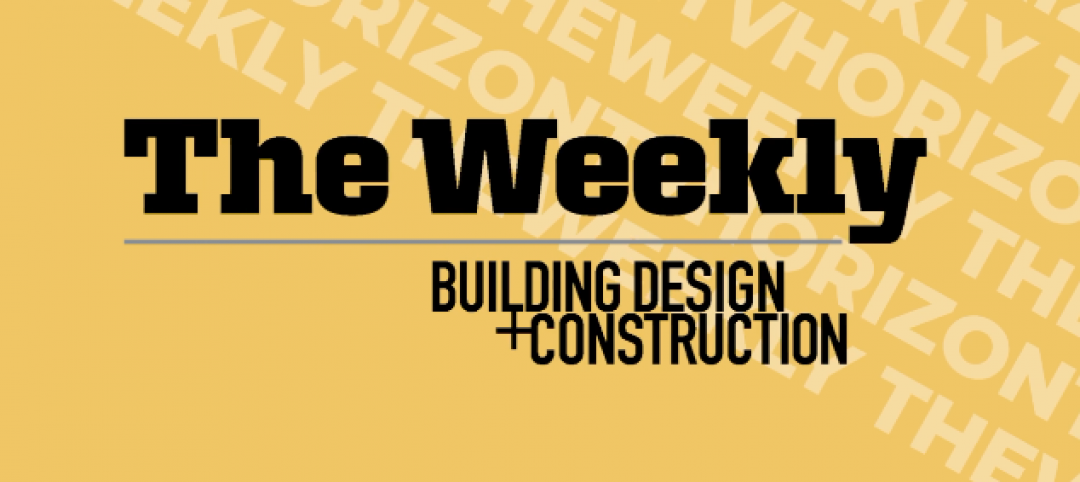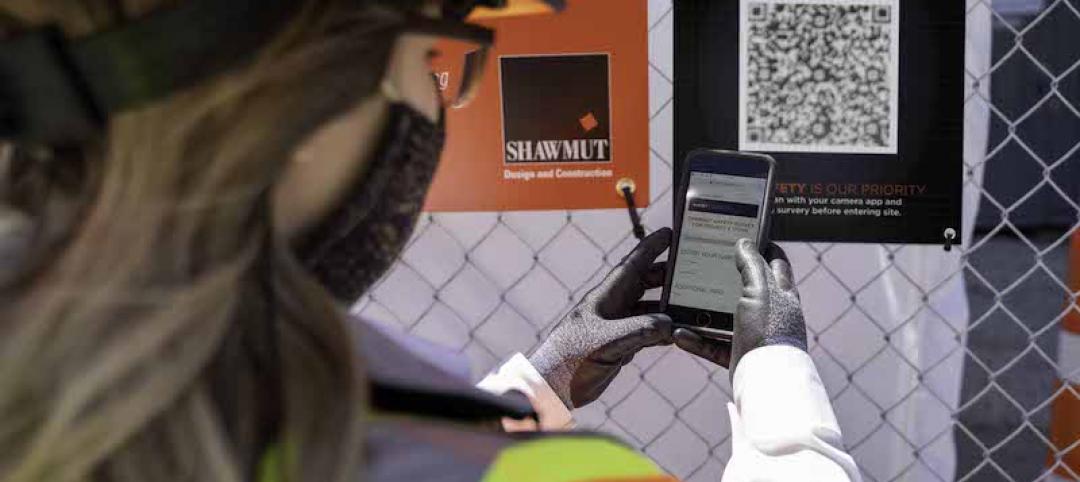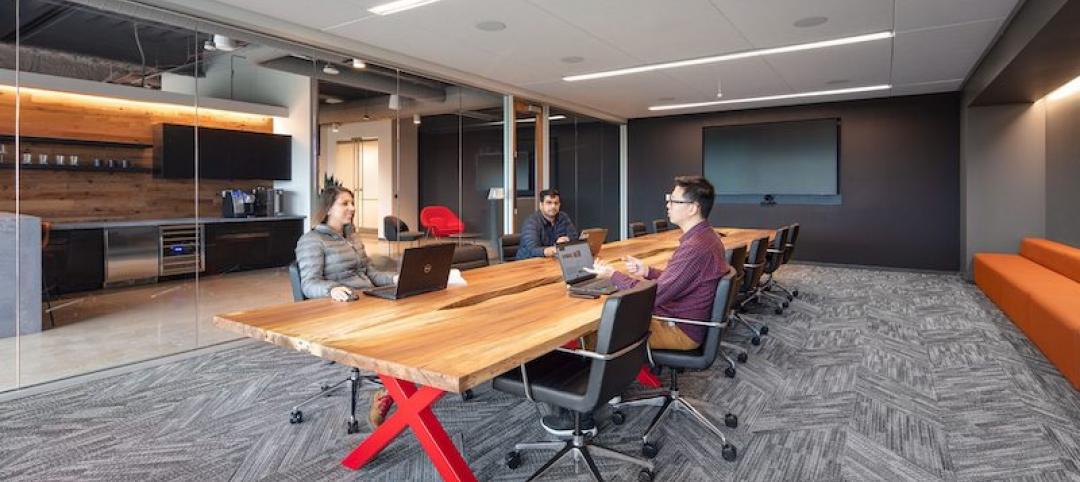Bringing people back downtown and to shopping streets will require confidence that the health crisis is abating, and a future outbreak will be minimized. States are now starting to re-open retail, and California Governor Gavin Newsom announced this week that California is moving to Phase Two of the State’s re-opening strategy, which includes some retail stores, with restrictions.
A vaccine is perhaps many months (or even years) away, and widespread testing infeasible in the near future. Cities and communities will need to adjust public space to allow customers back in with distancing in mind. Restaurants present an opportunity that already has many indicators of success: repurpose sidewalks, street-side parking, and parking lots into outdoor dining areas.
Alfresco dining offers the community a way to enjoy the outdoors while supporting restaurants. There is evidence Coronavirus does spread while airborne, but it may lose strength with sun and warm weather. Outdoor dining areas could be popular as the warmer summer months approach, and they would provide the area needed for establishments to enact social distancing while maintaining feasible occupancy levels.
Main Streets are critical parts of our cities’ economies and social culture, and they will need support during recovery to bring people back. More outdoor dining will send a signal to consumers that it's safe to go back out, with people being the biggest attractor of people.
As reported by Jon Henley, in the Guardian, Lithuania’s capital, Vilnius, has announced plans to turn the city into a vast open-air cafe by giving over much of its public space to the hard-hit bar and restaurant owners so they can put their tables outdoors and still observe physical distancing rules.
Kerry Cavanaugh, Los Angeles Times editorial writer who is focused on housing, transportation, and the environment, advocates that when Los Angeles starts allowing businesses to reopen in the coming weeks and months, the city could take a cue from Lithuania. She writes, “Of course, Lithuania is very different from Los Angeles. But L.A. could take some inspiration from Vilnius’ willingness to experiment with public spaces to help the city return to some safer version of normalcy. How about closing off parking spots or lanes to cars on some neighborhood commercial strips, so restaurants and cafes could place more tables outside? Or perhaps closing some less-traveled streets so people have more space to exercise outdoors while still socially distancing?”
Parklets
This approach has already been proven effective in Parklet programs in Southern California, where some curbside parking spaces have been converted to dining or congregating areas. The current situation with reduced traffic and parking demand may reduce the inevitable resistance to taking away parking spaces for other uses – a situation cities should take advantage of.
The Long Beach Parklet Program began in 2011 as a tactical urbanism pilot project deployed by Studio One Eleven in partnership with the City of Long Beach and privately-owned, local businesses.
Parklets are now part of the fabric of the City of Long Beach and have been hailed by the city as increasing community and encouraging walking and biking within the city, and as effective in uplifting economically disadvantaged areas.
By constructing street decks or concrete bulb-outs to expand the sidewalk, Parklets convert existing curbside parking stalls into outdoor seating, community gathering spots, and even areas for fitness activities. Each Parklet is tailored to the unique characteristics of its retail business partner, creating a vibrant public realm. The Parklets provide dining space for existing restaurants to expand while remaining in place. Parklets act to calm traffic and encourage pedestrian activity. Each Parklet design addresses environmental sustainability with recyclable materials and bio-swales that repurpose stormwater.
Creating Flex Zones
Cities can quickly establish retail and restaurant zones or ‘Flex Zones.’ Flex Zones are opportunities to provide temporary infrastructure similar to a Parklet, in a lighter, quicker, and cost-effective manner. Flex Zones serve to calm traffic while facilitating socially distanced dining and curbside pick-ups with cheerful surface graphics using materials such as spray chalk and stencils or even decals, along with modular structures and protective barriers like potted plants and water-filled k-rail. These are nimble ways to create temporary or longer-term outdoor zones that add atmosphere while establishing and communicating the new ways of interacting. Starting with the street, demarcation of crosswalks and added median structures and landscapes set the tone. Passenger loading zones (or restaurant take-out zones) can be clearly marked with consistent, easily recognizable, easily read signs that indicate passenger loading zone and its restraints, as well as direct drivers to the nearest long-term parking. In order to manage foot traffic for social distancing, a distancing lane on the sidewalk is marked for six feet while stations supply hand sanitizer to help stop the spread of infection.
Pop-up dining areas within these Flex Zones expand the capacity of a restaurant, enticing diners to the open-air seating that is pre-set for social distancing. The pop-up dining areas can be indicated with graphics that include where to sit and where not to sit. Cleaning standards and schedules are also posted. Flex Zones with dining areas can be created by repurposing existing streetside parking spots on traffic-calmed streets, the boundaries of the zone are set by using impact-resistant planters.
After an initial period of transition and pilot program, it is possible, or even likely, that perception will shift so communities will come to believe curbside space is actually too valuable for parking cars. These temporary zones can then be further developed as permanent parts of the urban fabric.
Relaxing Requirements
Cities can accelerate this movement by allowing for the conditional permitting of temporary zones and implementing pilot programs. These tactical interventions quickly and affordably make space for new uses that may include curbside pick-up and drop-off zones, pop-up dining, repurposing a vehicular travel lane or parking lane to create an extended sidewalk addressing the current demand on the public realm with the number of people walking right now for their mental health and exercise.
Temporary relaxing of permitting and licensing requirements will help facilitate the changes, and bring signs of much-needed vitality to shopping and dining districts, and most importantly, create conditions that serve to re-build restaurant patronage.
Examples of relaxed permitting and licensing abound, such as in California where wine, beer, and cocktails are now commonly offered on take-out menus, or as Henry Grabar writes in Slate: “In Brookhaven, a suburb of Atlanta, Mayor John Ernst has given restaurants permission to turn their parking into restaurant space. ‘For the next 90 days, Brookhaven will embrace alfresco dining,’ he said.”
A proven example, The Long Beach Parklet Program, which started as a pilot program, has inspired other cities in California and in Europe to inquire as to how to replicate the program in their respective cities. Now is the time to embrace this program and roll it out as a way to build community, encourage people out of their homes, and support the restaurant business and culture that is a distinctive part of what makes our cities cultural centers.


An existing Parklet, At Last Café in Long Beach, offers sidewalk dining, pictured here pre-Covid-19. The At Last Cafe Parklet site plan illustrates how this project, built as a bulb-out, added a four-way stop that calms traffic and encourages pedestrian activity.
Patrick West, Long Beach City Manager from 2007-2109, said, “One of the most unique and successful initiatives has been the Parklet Program, a great project for the City that demonstrated collaboration and a successful public-private partnership in place making. The impact and outcomes of the Program have been much more than just the retention of revenue and jobs. As a pioneering initiative, the Parklet Program garnered significant publicity and contributed to making the City of Long Beach a desirable place in Southern California.”
As a good idea generally for creating community, as Shelter-at-Home orders lift, this becomes an even better idea for reopening our cities.
About the Authors
Alan Pullman, AIA, is Founding Principal, and Shannon Heffernan, AICP, is Urban Design Director and Senior Associate with Studio One Eleven.
Related Stories
Coronavirus | Jun 30, 2020
The great reset and our new work life
As many countries begin to return to the office, it’s a chance to ask ourselves: what do we truly value?
Coronavirus | Jun 26, 2020
Infection control in buildings in the age of the coronavirus
Controlling future infection spreads could become job one for most buildings and spaces.
Coronavirus | Jun 26, 2020
ICYMI The Weekly show: The hotel sector's 'competition for cleanliness' and workplace design amid COVID-19
This week on The Weekly (June 25 episode), BD+C editors spoke with leaders from Skidmore, Owings & Merrill, Henderson Engineers, and Shawmut Design & Construction on three timely topics.
Coronavirus | Jun 23, 2020
A look back at design standard shifts: ADA vs. COVID-19
The short story is official design guidelines are slow to be developed and made into law.
Coronavirus | Jun 23, 2020
WATG designs solution for isolating without sacrificing social connectivity
The design was inspired by oriel bay windows.
Coronavirus | Jun 22, 2020
Boldt creates an innovation task force to speed up safe opening of jobsites, 14 offices
Boldt creates an innovation task force to speed up safe opening of jobsites, 14 offices
Coronavirus | Jun 19, 2020
Experts address COVID-19's impact on nursing homes and schools on The Weekly
The June 18 episode of BD+C's "The Weekly" is available for viewing on demand.
Coronavirus | Jun 18, 2020
Brown University tops off first housing building in three decades
The facility, scheduled for completion next April, will combine a residence hall with student health services.
Coronavirus | Jun 17, 2020
HOK and Germfree partner to design mobile COVID-19 testing lab
Access to quick, reliable, and repeated testing has been one of the greatest challenges for businesses, institutions and individuals during the COVID-19 crisis.
Coronavirus | Jun 17, 2020
Guiding changes in the workplace: Past, present, and future
Since the COVID-19 pandemic, many companies are managing sudden change as they assess the impact on workplace design and how people use spaces.


